If I tell you that, you don’t have to step out of your house and everything will be available to you at your doorstep without any hassle, will you believe me? I am sure you won’t! No, we are not bluffing. The accessibility and advancement of e-commerce stores in India have made the Indian lifestyle much easier, similar to that of Western countries. In this article, we will discuss a great deal about e-commerce stores in India and how you can set up one.
Table of Contents:
- What is an E-commerce ?
- What is an E-commerce Store?
- What Is An Ecommerce Website or Store?
- Types Of Ecommerce Websites
- How Does Ecommerce Work?
- Ecommerce Website Legal Requirements:
- How To Set Up an E-commerce Store In India?
- Bikayi As An Ecommerce Enabler
- How to setup e-commerce store on On Bikayi App
- How to setup e-commerce store on Bikayi’s Website
- Frequently Asked Questions
1. What is E-commerce?
E-commerce is the activity of buying and selling goods and services using the internet as a medium. The act of purchasing or selling anything is called commerce, doing it online on the internet or on the phone, is e-commerce. Whatever you wish to buy, from food products to a lavish car, are available on the internet in the form of an e-commerce store. Ecommerce is also known as e-business or electronic business.
2. What is an E-commerce Store?
An e-commerce store is an online store where you can buy goods and services. Purchasing from an ecommerce or an online store is much easier than purchasing from a normal store because you can comfortably place your order simply by sitting at the comfort of your home. What’s better? You can track your order too. All online orders come with information about their estimated delivery date and it’s part of the customer service they provide. An e-commerce store in India also provides you with a variety of options to choose from with every single detail mentioned in their description. With the advancement of technology, you can also upload a picture of what you want to buy on the web and run a search to see if it’s available to order. Fascinating, right?
3. What is an Ecommerce Website or Store?
In simple words, an ecommerce website or store is an online portal where you can indulge in buying or selling goods and services. Through ecommerce websites, you can place orders, make payments, track your shipping and also read what other customers have to say about their purchase in terms of ‘reviews’.
4. Types of Ecommerce Websites:
The e-commerce websites can be classified into the following types-
- Business-to-consumer (B2C) – This is one of the most common types of business, where there is a direct exchange of goods between a business and a consumer. A few examples of B2C brands that you may be familiar with are: Myntra, Nike, Air BNB, Starbucks, GoPro, etc.
- Business-to-business (B2B) – These websites allow customers to buy and sell products between two businesses. For example, the purchasing or selling between a wholesaler and a retailer can be done through B2B websites. A few examples to name here are Apple, Google, IBM, Intel, etc
- Business-to-administration (B2A) – Through these websites, you can perform the transactions between a business and a public institution. When A government-related organization purchases or sells anything to a business company, then it is referred to as B2A. The best example of B2A is Accela.com.
- Consumer-to-consumer (C2C) – C2C websites allow a consumer to trade with another consumer in an online environment. The best examples of C2C business are Alibaba, eBay, Mercari, Etsy, etc.
- Consumer-to-Business (C2B) – C2C businesses include consumers offering services to other business websites. Websites that provide opportunities to freelancers are examples of C2B websites. A few to name are companies such as Upwork, Fiverr, and Scripted.
- Consumer-to-administration (C2A) – In this type of business model, consumers provide goods, information, and services to government-related organizations. It includes all electronic transactions between government and public administrations. Websites that perform electronic tax filing, paying toll tax, and other government-related activities come under C2A websites. The income tax department’s e-payment website is the best example of a C2A website.
5. How Does Ecommerce Work?
If you know how a normal offline retail business works, e-commerce business functions in a similar fashion. Understand the functioning of an e-commerce set-up more simply, let’s say it is classified into three categories:
- Receiving Orders– In this step, the customers place an order from an e-commerce store. During this time, the customer’s information is recorded, applicable tax is calculated, their order and tracking numbers are generated, the delivery details are shared, the billing information is processed and finally the access to the billing gateway is provided.
- Payment- The payment is done via payment gateways. Under this step, the payment option is chosen from a list of options like a Credit card, Debit card, UPI, Wallet, and more. After this multi-step authentication is done for secure payments.
- Shipping- This process is done once the order is placed. Typically it means that the item has left the warehouse of the supplier.
6. Ecommerce Website Legal Requirements:
If you don’t want yourself to get indulged in legal trouble regarding your e-commerce store in India, then you should fulfill all the legal requirements beforehand. A few of the legal requirements for e-commerce websites are:
- Business registration- You need to register your business as a private limited company, limited liability partnership, or one-person company. Through this registration, you can specify your liabilities and opt for tax benefits too.
- VAT/Sales Tax Registration- The two types of sales tax are: VAT (Value added tax) and the other is CST (Central sales tax). To start your e-commerce business, you need to register for both these taxes. VAT is applied on each stage of production or distribution, while CST is not applied on each stage of production and distribution. VAT and CST both are indirect taxes. CST is applied in interstate sales.
- Vendor Agreement- This agreement is for defining the expectations of the parties. Under this agreement, the vendor list is stated in the portal.
- Intellectual property protection- This is for ensuring that while conducting this business, nobody’s intellectual property is being affected. Also, it ensures that your intellectual property is also protected.
7. How to Set Up an E-commerce Store in India?
Setting up an e-commerce store may sound complex, but in reality, it is way simpler than you think. To set up an e-commerce store in India, you need to follow the following steps: Step 1- Choose an e-commerce platform where you want to create your online store.
Step 2- After choosing the platform, you need to purchase a domain name.
Step 3- After this step, you need to choose your e-commerce theme and customize your e-commerce template.
Step 4- Once the above steps are done, you need to add your products.
Step 5– After this, you need to set up your payment options.
Step 6– Once the above steps are completed, you need to preview, test, and publish your online store.
8. Bikayi as an Ecommerce Enabler:
Bikayi is one of India’s most efficient and well-known e-commerce enablers. At Bikayi, we understand the significance of e-commerce in today’s world. Thus, we allow you to create your e-commerce store seamlessly. All it takes is 90 seconds to create your online ecommerce store with Bikayi, and We empower 5M+ businesses to build, grow, and achieve success in the online world. You can also generate ecommerce store names with Bikayi’s free business name generator.
9. How to Set up E-commerce Store on Bikayi App
There are two ways by which you can start your e-commerce store on Bikayi: Through Bikayi App- To start your eCommerce store via the Bikayi app, you need to follow the following steps: Step 1- Download the Bikayi app  Step 2- Click on Start using Bikayi
Step 2- Click on Start using Bikayi  Step 3- Enter your phone number for OTP
Step 3- Enter your phone number for OTP  Step 4- After this you will receive an OTP, enter it and click on Login.
Step 4- After this you will receive an OTP, enter it and click on Login. 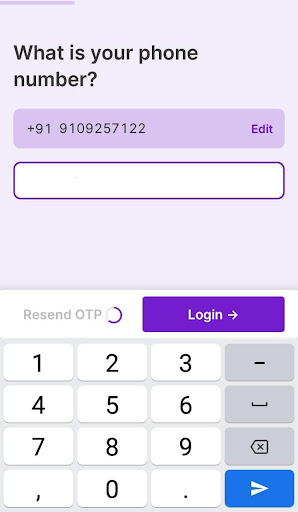 Step 5- Enter the name of your business.
Step 5- Enter the name of your business. 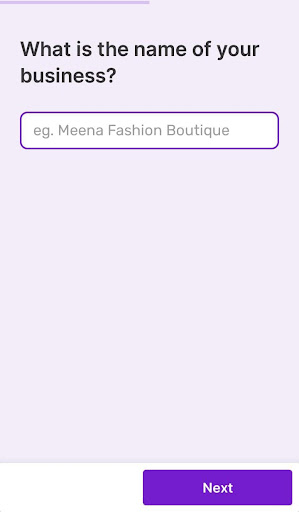 Step 6- Add your products to your store. For this add the Product’s name, photos, description, price, and other details.
Step 6- Add your products to your store. For this add the Product’s name, photos, description, price, and other details.  Step 7- Click on Save.
Step 7- Click on Save. 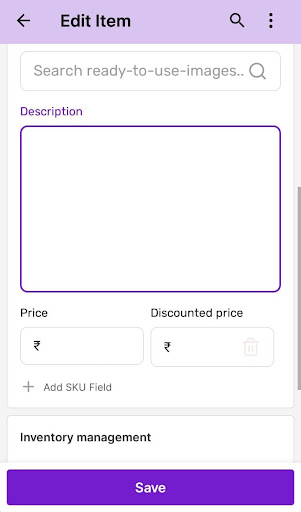
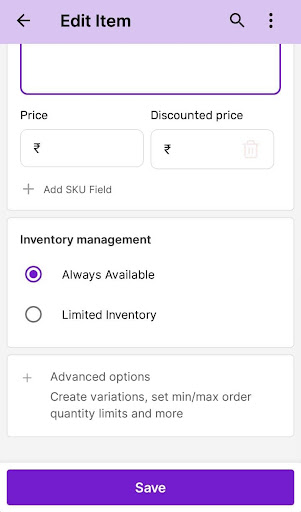 Step 8- Now your Online Store is ready on Bikayi.
Step 8- Now your Online Store is ready on Bikayi. 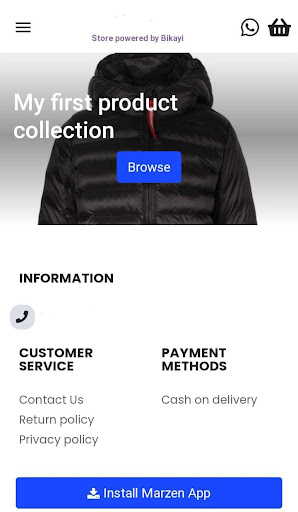
10. How to setup e-commerce store on Bikayi’s Website
To start your e-commerce store through Bikayi, you need to follow the following steps: Step 1- Go to the official website of Bikayi 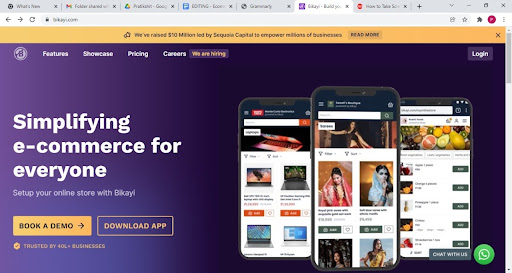 Step 2- Click on login. Step 3- Login using your mobile number, email address, or by connecting your Facebook (Meta) account.
Step 2- Click on login. Step 3- Login using your mobile number, email address, or by connecting your Facebook (Meta) account. 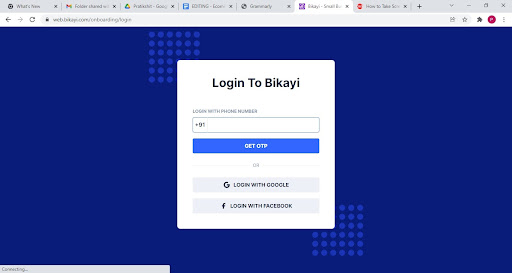 Step 4- Complete the steps by answering a few questions about your business.
Step 4- Complete the steps by answering a few questions about your business. 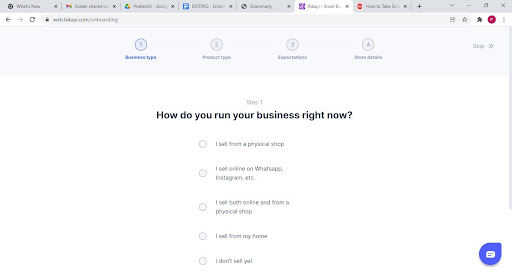
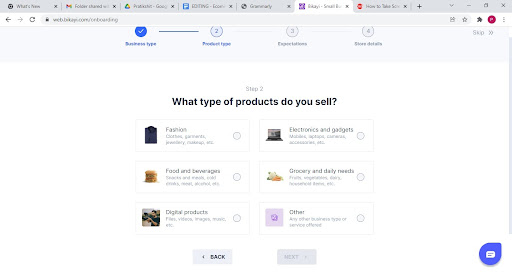 Step 5- Enter your store name and your name.
Step 5- Enter your store name and your name. 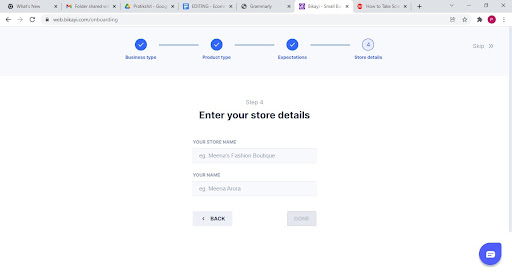 Step 6- Click on Done, and you will get the link to your ecommerce store.
Step 6- Click on Done, and you will get the link to your ecommerce store. 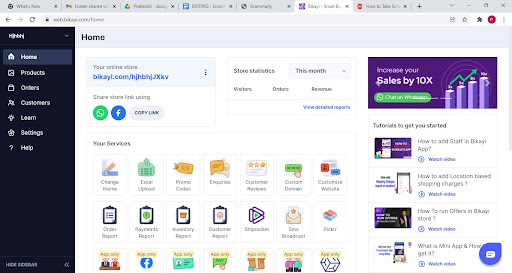
If I tell you that, you don’t have to step out of your house and everything will be available to you at your doorstep without any hassle, will you believe me? I am sure you won’t! No, we are not bluffing. The accessibility and advancement of e-commerce stores in India have made the Indian lifestyle much easier, similar to that of Western countries. In this article, we will discuss a great deal about e-commerce stores in India and how you can set up one.
Table of Contents:
- What is an E-commerce ?
- What is an E-commerce Store?
- What Is An Ecommerce Website or Store?
- Types Of Ecommerce Websites
- How Does Ecommerce Work?
- Ecommerce Website Legal Requirements:
- How To Set Up an E-commerce Store In India?
- Bikayi As An Ecommerce Enabler
- How to setup e-commerce store on On Bikayi App
- How to setup e-commerce store on Bikayi’s Website
- Frequently Asked Questions
1. What is E-commerce?
E-commerce is the activity of buying and selling goods and services using the internet as a medium. The act of purchasing or selling anything is called commerce, doing it online on the internet or on the phone, is e-commerce. Whatever you wish to buy, from food products to a lavish car, are available on the internet in the form of an e-commerce store. Ecommerce is also known as e-business or electronic business.
2. What is an E-commerce Store?
An e-commerce store is an online store where you can buy goods and services. Purchasing from an ecommerce or an online store is much easier than purchasing from a normal store because you can comfortably place your order simply by sitting at the comfort of your home. What’s better? You can track your order too. All online orders come with information about their estimated delivery date and it’s part of the customer service they provide. An e-commerce store in India also provides you with a variety of options to choose from with every single detail mentioned in their description. With the advancement of technology, you can also upload a picture of what you want to buy on the web and run a search to see if it’s available to order. Fascinating, right?
3. What Is An Ecommerce Website or Store?
In simple words, an ecommerce website or store is an online portal where you can indulge in buying or selling goods and services. Through ecommerce websites, you can place orders, make payments, track your shipping and also read what other customers have to say about their purchase in terms of ‘reviews’.
4. Types Of Ecommerce Websites:
The e-commerce websites can be classified into the following types-
- Business-to-consumer (B2C) – This is one of the most common types of business, where there is a direct exchange of goods between a business and a consumer. A few examples of B2C brands that you may be familiar with are: Myntra, Nike, Air BNB, Starbucks, GoPro, etc.
- Business-to-business (B2B) – These websites allow customers to buy and sell products between two businesses. For example, the purchasing or selling between a wholesaler and a retailer can be done through B2B websites. A few examples to name here are Apple, Google, IBM, Intel, etc
- Business-to-administration (B2A) – Through these websites, you can perform the transactions between a business and a public institution. When A government-related organization purchases or sells anything to a business company, then it is referred to as B2A. The best example of B2A is Accela.com.
- Consumer-to-consumer (C2C) – C2C websites allow a consumer to trade with another consumer in an online environment. The best examples of C2C business are Alibaba, eBay, Mercari, Etsy, etc.
- Consumer-to-Business (C2B) – C2C businesses include consumers offering services to other business websites. Websites that provide opportunities to freelancers are examples of C2B websites. A few to name are companies such as Upwork, Fiverr, and Scripted.
- Consumer-to-administration (C2A) – In this type of business model, consumers provide goods, information, and services to government-related organizations. It includes all electronic transactions between government and public administrations. Websites that perform electronic tax filing, paying toll tax, and other government-related activities come under C2A websites. The income tax department’s e-payment website is the best example of a C2A website.
5. How Does Ecommerce Work?
If you know how a normal offline retail business works, e-commerce business functions in a similar fashion. Understand the functioning of an e-commerce set-up more simply, let’s say it is classified into three categories:
- Receiving Orders– In this step, the customers place an order from an e-commerce store. During this time, the customer’s information is recorded, applicable tax is calculated, their order and tracking numbers are generated, the delivery details are shared, the billing information is processed and finally the access to the billing gateway is provided.
- Payment- The payment is done via payment gateways. Under this step, the payment option is chosen from a list of options like a Credit card, Debit card, UPI, Wallet, and more. After this multi-step authentication is done for secure payments.
- Shipping- This process is done once the order is placed. Typically it means that the item has left the warehouse of the supplier.
6. Ecommerce Website Legal Requirements:
If you don’t want yourself to get indulged in legal trouble regarding your e-commerce store in India, then you should fulfill all the legal requirements beforehand. A few of the legal requirements for e-commerce websites are:
- Business registration- You need to register your business as a private limited company, limited liability partnership, or one-person company. Through this registration, you can specify your liabilities and opt for tax benefits too.
- VAT/Sales Tax Registration- The two types of sales tax are: VAT (Value added tax) and the other is CST (Central sales tax). To start your e-commerce business, you need to register for both these taxes. VAT is applied on each stage of production or distribution, while CST is not applied on each stage of production and distribution. VAT and CST both are indirect taxes. CST is applied in interstate sales.
- Vendor Agreement- This agreement is for defining the expectations of the parties. Under this agreement, the vendor list is stated in the portal.
- Intellectual property protection- This is for ensuring that while conducting this business, nobody’s intellectual property is being affected. Also, it ensures that your intellectual property is also protected.
7. How To Set Up an E-commerce Store In India?
Setting up an e-commerce store may sound complex, but in reality, it is way simpler than you think. To set up an e-commerce store in India, you need to follow the following steps: Step 1- Choose an e-commerce platform where you want to create your online store.
Step 2- After choosing the platform, you need to purchase a domain name.
Step 3- After this step, you need to choose your e-commerce theme and customize your e-commerce template.
Step 4- Once the above steps are done, you need to add your products.
Step 5– After this, you need to set up your payment options.
Step 6– Once the above steps are completed, you need to preview, test, and publish your online store.
8. Bikayi As An Ecommerce Enabler:
Bikayi is one of India’s most efficient and well-known e-commerce enablers. At Bikayi, we understand the significance of e-commerce in today’s world. Thus, we allow you to create your e-commerce store seamlessly. All it takes is 90 seconds to create your online ecommerce store with Bikayi, and We empower 5M+ businesses to build, grow, and achieve success in the online world. You can also generate ecommerce store names with Bikayi’s free business name generator.
9. How to setup e-commerce store on Bikayi App
There are two ways by which you can start your e-commerce store on Bikayi: Through Bikayi App- To start your eCommerce store via the Bikayi app, you need to follow the following steps: Step 1- Download the Bikayi app  Step 2- Click on Start using Bikayi
Step 2- Click on Start using Bikayi  Step 3- Enter your phone number for OTP
Step 3- Enter your phone number for OTP  Step 4- After this you will receive an OTP, enter it and click on Login.
Step 4- After this you will receive an OTP, enter it and click on Login.  Step 5- Enter the name of your business.
Step 5- Enter the name of your business.  Step 6- Add your products to your store. For this add the Product’s name, photos, description, price, and other details.
Step 6- Add your products to your store. For this add the Product’s name, photos, description, price, and other details.  Step 7- Click on Save.
Step 7- Click on Save. 
 Step 8- Now your Online Store is ready on Bikayi.
Step 8- Now your Online Store is ready on Bikayi. 
10. How to setup e-commerce store on Bikayi’s Website
To start your e-commerce store through Bikayi, you need to follow the following steps: Step 1- Go to the official website of Bikayi  Step 2- Click on login. Step 3- Login using your mobile number, email address, or by connecting your Facebook (Meta) account.
Step 2- Click on login. Step 3- Login using your mobile number, email address, or by connecting your Facebook (Meta) account.  Step 4- Complete the steps by answering a few questions about your business.
Step 4- Complete the steps by answering a few questions about your business. 
 Step 5- Enter your store name and your name.
Step 5- Enter your store name and your name.  Step 6- Click on Done, and you will get the link to your ecommerce store.
Step 6- Click on Done, and you will get the link to your ecommerce store. 
11. Frequently Asked Questions
What exactly is e-commerce?
What are the main types of e-commerce websites?
What is the purpose of e-commerce?
Related pages
ALL ARTICLES
Top 10 Fastest-Growing E-Commerce Categories in 2022
Due to digitization in every segment and industry globally, people are prone to smartphones and smart appliances. This led e-commerce to propagate at an incredibly faster pace. Electronic commerce refers…
3 Reasons Why You Need A Location Checker On Your Website
We can agree that running an e-commerce store or having an online business automatically opens up the visibility of your business and accords it a wider reach. It is important…
4 Reasons Why Size Charts Are Necessary For Your Online Store
Do you have an online store that deals with products in sectors like clothing, apparel and footwear? Do you own an e-commerce business that needs a size chart to make…
Why Wishlists Are an Important Feature in E-Commerce?
Are you an e-commerce business owner and wondering how to drive shoppers to your store? As an online store owner, you might find it challenging to fit in the needs…
Best Ecommerce Platform for Business: What Is an Ecommerce Platform? Best Ecommerce Platform List
The e-commerce sector unexpectedly saw an instant boom after the pandemic brought the world to a standstill in 2020. If statistics have to be believed, the e-commerce industry will hit…








